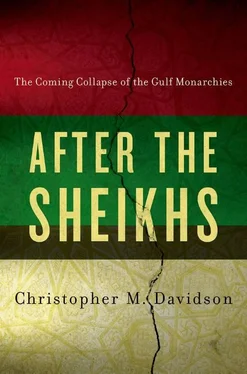Development assistance and international charity
Since the 1970s the wealthier Gulf monarchies — notably Saudi Arabia, the UAE, and Kuwait — have been among the biggest donors of development aid to the poorer Arab states in the Middle East and North Africa. More recently they have been joined by gas-rich Qatar, and their aid programmes have now reached out much further, with countless donations to communities in East Africa, South Asia, South East Asia, and even Eastern Europe. Most of the aid has been carefully controlled by the Gulf monarchies’ respective ministries for foreign affairs or by well-established state-controlled institutions such as the Saudi Fund for Development (set up in 1974), the Abu Dhabi Fund for Development (which dates from 1971 under the name Abu Dhabi Fund for Arab Development), [310] 2. Wheatcroft, Andrew, With United Strength: Sheikh Zayed bin Sultan Al-Nahyan, the Leader and the Nation (Abu Dhabi: Emirates Centre for Strategic Studies and Research, 2005), p. 185.
and the Kuwait Fund for Arab Economic Development (established in 1961, making it the first foreign aid vehicle set up by a developing state). However, such official development assistance (ODA) is only part of the story, given the many individual ruling family members and other state-sponsored charities in the Gulf monarchies also involved in such activities. The UAE has probably gone the furthest in trying to organise its various efforts under one umbrella, by setting up an External Aid Liaison Bureau in 2008. This was partly a response to disbelief and criticism from various United Nations representatives following a potentially accurate claim from a UAE minister that 3.6 per cent of GDP was allocated to development aid. [311] 3. The National , 11 July 2008.
Unsurprisingly, given the various rulers’ described efforts to boost their personal legitimacy, many of the more tangible results of development assistance (such as hospitals, mosques, and schools) in recipient countries are named after the monarch in question.
Overall, throughout the period 1976–2006 it was estimated that over 4.2 per cent of Saudi Arabia’s GDP or about $49 billion was devoted to development aid, [312] 4. The Daily Telegraph , 26 March 2006.
while in the UAE, Kuwait, and Qatar it is thought that aid has often been over 3 per cent of GDP. Although this is still much less than the Gulf monarchies spend on military hardware — which is usually between 4 and 11 per cent of GDP [313] 5. Stockholm International Peace Research Institute, Military Expenditure Database. In 2010 Saudi Arabia was at 11.2 per cent, UAE 7.3 per cent, and Kuwait 4.4 per cent.
—the gap does seem to be narrowing as ODA becomes an increasingly central pillar of foreign policy for these states. It is important to appreciate that Gulf ODA as a percentage of GDP is often higher than in the West, including the United States. In the Arab world, Palestine has unsurprisingly been the oldest and most generously targeted ODA destination. Over the past decade Saudi Arabia has supplied the Palestinian Authority with nearly $500 million in aid, and in addition has channelled hundreds of millions of dollars to help Palestinian refugees through both the Arab League and the United Nations Relief and Works Agency. Today it is thought that Saudi Arabia alone provides Palestine with between $14 million and $17 million per month. [314] 6. CNN , 22 February 2006.
Likewise, the UAE has supplied Palestine with considerable aid over the years and in the past decade it is thought that over $4 billion has been provided, including a $62 million residential complex built in 2004 and named after Abu Dhabi’s late ruler, Zayed bin Sultan Al-Nahyan, and the $70 million rebuilding of the Jenin Camp after its destruction in 2002. [315] 7. ( in Arabic ) Mutawwa, Khalid, The Arabic Falcon (Sharjah, 2005), pp. 214–215.
Crucially, despite Hamas’ surprise election victory in 2006, Gulf ODA to Palestine has not slowed. If anything, it has accelerated — perhaps best symbolised by the Sheikh Khalifa bin Zayed Mosque in Bethany, named after Abu Dhabi’s current ruler. At a cost of nearly $5 million, the mosque will have the tallest minarets in Palestine when complete. [316] 8. The National , 27 July 2008.
This response contrasts with other donors such as the US — which has been reviewing its aid programme given Hamas’ ostensible ties to terror organisations. [317] 9. Associated Press , 12 July 2011. Senator Gary Ackerman of New York, a Democrat on the House Foreign Affairs subcommittee on the Middle East and South Asia, stated that ‘As a matter of both law and basic decency, we will never do business with or provide aid to a government controlled by or reporting to terrorists’.
As such, the Gulf monarchies’ role in Palestine’s development is now unparalleled.
The Lebanon has been another major Gulf ODA destination, given its similar centrality and relevance to regional politics. After the resolution of the Lebanese civil war in 1990, the UAE injected between $500 and $700 million into the stricken country, and funding was provided for the Lebanese Army to purchase high-tech mine-clearing equipment. [318] 10. ( in Arabic ) Hamza, Kamal, Zayed: A Mark on the Forehead of History (Abu Dhabi, 2005), p. 166.
Following the 2006 conflict with Israel, the UAE Red Crescent Society provided Lebanon with a further $300 million as part of the Emirates Solidarity Project. Most of the money has been spent on rebuilding physical infrastructure damaged by Israeli bombing and constructing new hospitals and schools. [319] 11. The National , 18 July 2008.
Since then the UAE is believed to have pledged and delivered a further $300 million in aid to Lebanon. [320] 12. US Department of State, ‘Background Note: United Arab Emirates’ 2011.
In 2006 and 2007 Saudi Arabia provided the Lebanese Central Bank with nearly $2.7 billion, including $500 million to be spent on reconstruction. [321] 13. Voice of America , 25 July 2006.
Qatar has been equally keen to assist, having ploughed an estimated $250 million into rebuilding Bin Jbeil — the most badly damaged Lebanese town in the 2006 war. Much of this money was used to construct 12,000 new houses and repair 470 places of worship — including Sunni and Shia mosques and Christian churches. [322] 14. Der Spiegel , 13 March 2007.
Iraq has been a more problematic recipient of aid from the Gulf monarchies, mostly due to Kuwait’s insistence that the post-2003 Iraqi government eventually repays about $16 billion of loans — most of which were provided to Saddam Hussein’s government by Kuwaiti banks prior to Iraq’s invasion of Kuwait in 1990. Nevertheless, in its keenness to head off Iranian encroachment in Iraq, Saudi Arabia’s assistance has been very generous, ranging from reconstruction projects to the pledging of billions of dollars of export guarantees and the providing of massive soft loans. The UAE’s assistance to Iraq has perhaps been even greater, with several large donations having been made since 2005, including a gift of $215 million for the reconstruction effort, [323] 15. Mutawwa (2005), p. 99.
and the UAE Armed Forces’ supplying of helicopters and other equipment for the new Iraqi military. [324] 16. Islamic Republic News Agency , 16 January 2004.
In summer 2008 the UAE announced that it would also scrap all of Iraq’s outstanding debts to the UAE — amounting to some $7 billion — so as to ‘help alleviate the economic burdens endured by the brotherly Iraqi people’. [325] 17. Davidson, Christopher M., Abu Dhabi: Oil and Beyond (London: Hurst, 2009), chapter 6.
Читать дальше












